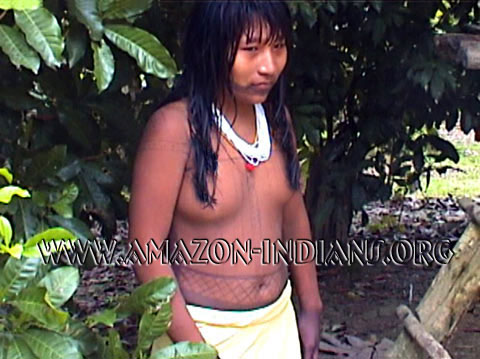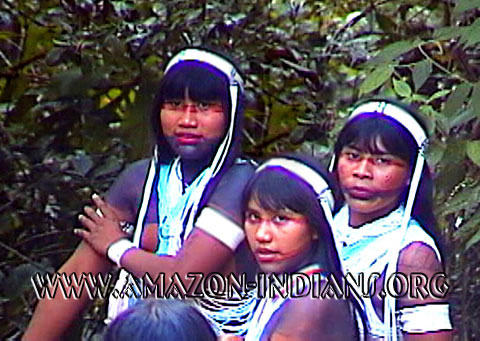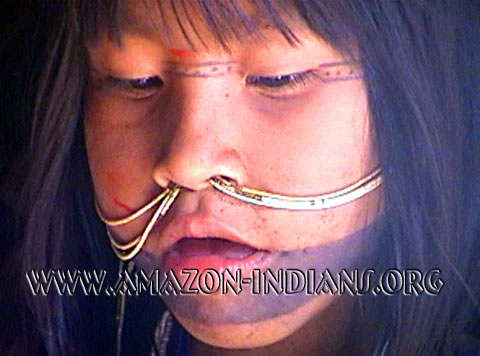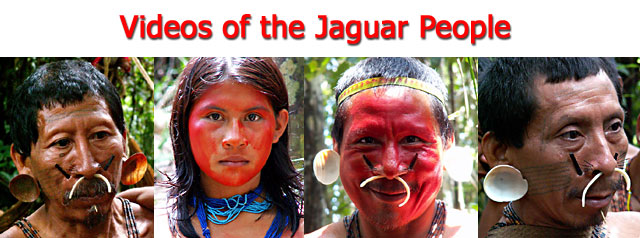|
f
all the tribes that inhabit the Javarí River Valley of Brazil and Peru, the
Marubo Indians are the largest and most powerful. The Marubo were the first
indigenous people in the Javarí to make contact with outsiders at the turn of
the 20th century. Consequently, to the detriment of other tribes in the Valley,
they were the first to get access to weapons such as shotguns. To this day the
Marubo Indians dominate all the other tribes in the Javarí. For example, when I
first sought access to the Matis Indians, it was necessary for me to first
contact the Marubo cacique (chief) who subsequently gave me permission to visit
the Matis.
The Marubo language is a member of the Pano family which includes other native
languages such as Matis, Korubo, Matsés (Mayoruna), and Shipibo. Generally,
young Marubo men speak some Portuguese. However, women rarely speak any
Portuguese and have little or no contact with outsiders. Since the entire Javarí
Valley area was originally a part of Peru and pioneered by Peruvian rubber
tappers, older people tend to speak some Spanish.
 The
impact of the rubber trade in the early 20th century was devastating to the
Marubo. Most became involved in the rubber industry, and were locked into debt
by the rubber barons. Worse, the rubber trade caused traditional communities to
become fragmented. Rubber collecting required that each family lived solitarily
to gather their rubber. Collecting rubber took precedence over the religious and
cultural traditions of the community. By the time the rubber boom collapsed in
1938, the rubber trade had reduced the Marubo people and their culture to near
extinction. The
impact of the rubber trade in the early 20th century was devastating to the
Marubo. Most became involved in the rubber industry, and were locked into debt
by the rubber barons. Worse, the rubber trade caused traditional communities to
become fragmented. Rubber collecting required that each family lived solitarily
to gather their rubber. Collecting rubber took precedence over the religious and
cultural traditions of the community. By the time the rubber boom collapsed in
1938, the rubber trade had reduced the Marubo people and their culture to near
extinction.
Interestingly, in the Marubo religion, new life forms are said to originate from
the transformation or aggregation of parts of dead and destroyed organisms. To
make an analogy, present day Marubo society appears to have resulted from the
rebirth of Marubo families destroyed and fragmented by the rubber trade.
However, this process of scattering and transformation may not be new to the
Marubo and may well go back into prehistoric times, because the influence of the
Marubo language and names is very evident in many other Pano tribes.
 Until
the 1970s, the Javarí Valley was a wild and lawless area. The Matsés (not to be
confused with the Matis) or Mayoruna people were well-known for abducting women
from other tribes. One famous incident took place in the 1960s when a group of
Marubos were collecting tortoise eggs on a beach on the Curuçá River. The
Mayoruna killed the men and kidnapped the women. This raid provoked a reprisal
from the Marubo. The Marubo obtained firearms through their contact with whites
and undertook an expedition that decimated an entire village of Mayorunas. By
the 1970s it was necessary for the Brazilian government to enter the area and
end the cycle of abductions and reprisals. Through interventions by whites, many
of the abducted women were returned to the Marubo, although some had died and
some chose to remain, having been assimilated into Mayoruna society. Until
the 1970s, the Javarí Valley was a wild and lawless area. The Matsés (not to be
confused with the Matis) or Mayoruna people were well-known for abducting women
from other tribes. One famous incident took place in the 1960s when a group of
Marubos were collecting tortoise eggs on a beach on the Curuçá River. The
Mayoruna killed the men and kidnapped the women. This raid provoked a reprisal
from the Marubo. The Marubo obtained firearms through their contact with whites
and undertook an expedition that decimated an entire village of Mayorunas. By
the 1970s it was necessary for the Brazilian government to enter the area and
end the cycle of abductions and reprisals. Through interventions by whites, many
of the abducted women were returned to the Marubo, although some had died and
some chose to remain, having been assimilated into Mayoruna society.
Rites of passage ceremonies per se do not exist in the Marubo culture as
compared to the Ticunas. However, men are not permitted to use tobacco snuff and
ayahuasca until they have attained an age of about thirty years. Prior to this
age, young Marubo men are limited to serving the needs of older men. There is a
distinct division of labor between man and women, with men responsible for
clearing the forest for plantations, hunting, making canoes, and carving drums.
In addition, shamanism and traditional medicine are all male tasks.
 In
contrast, women are responsible for harvesting crops, cooking, creating pottery,
and weaving hammocks. Marubo women spend much of their time making beads from
snail shells. These beads are used to create the nose ornaments that
characterize the Marubo. In addition, gastropod shell beads are used to make
necklaces, chest bands, and the pendant crowns that are distinctive elements of
Marubo attire. All body painting, whether for ceremonies or merely esthetic, is
performed by women. In
contrast, women are responsible for harvesting crops, cooking, creating pottery,
and weaving hammocks. Marubo women spend much of their time making beads from
snail shells. These beads are used to create the nose ornaments that
characterize the Marubo. In addition, gastropod shell beads are used to make
necklaces, chest bands, and the pendant crowns that are distinctive elements of
Marubo attire. All body painting, whether for ceremonies or merely esthetic, is
performed by women.
In present day, shotguns are used in place of traditional blowguns or bows and
arrows. The primary game species are two varieties of monkeys, the wooly monkey
(Lagothrix logothricha) and the spider monkey (Ateles belzebuth).
Curiously, other species of primates are considered inedible. They also hunt the
queixada (Tayassu pecari, a peccary that is native to the Amazon), the
collared peccary (Tayassu tajacu) and the tapir (Tapirus terrestris)
 Although
lines and hooks are sometimes used, fishing is typically done using a plant
mixture called “huaca.” Huaca is processed by adding the plant (Lonchocarpus
floribundus) to clay and fermenting the mixture. When dissolved in a body of
water such as a lake, huaca depletes the oxygen and the fish float to the
surface and are harvested. Although
lines and hooks are sometimes used, fishing is typically done using a plant
mixture called “huaca.” Huaca is processed by adding the plant (Lonchocarpus
floribundus) to clay and fermenting the mixture. When dissolved in a body of
water such as a lake, huaca depletes the oxygen and the fish float to the
surface and are harvested.
The Marubo practice various ceremonies and rituals, one of the most interesting
being the Ceremony of Áco. Áco begins with the transportation of a giant log
from the forest to the “maloca” (big house). The log is not dragged on the
ground as one might suspect. Instead it is carried on the shoulders of the men.
It is a difficult task and the men use sticks to support themselves as they make
the strenuous journey. While the men are transporting the log, the women flirt
and tease prospective mates by tickling them. In the maloca, the log is carved
into a drum by the men, while the women dance and sing, praying to their dead
ancestors for success in hunting and bountiful harvests.
 If
you would like to learn how you can meet the Marubo and find out how you can
help them preserve their culture, please contact me at
djpantone@amazon-indians.org. For more information about
other Amazon Indians, please visit
www.amazon-indians.org/matis. Documentary films of my expeditions with the Matis
are
available on video. If
you would like to learn how you can meet the Marubo and find out how you can
help them preserve their culture, please contact me at
djpantone@amazon-indians.org. For more information about
other Amazon Indians, please visit
www.amazon-indians.org/matis. Documentary films of my expeditions with the Matis
are
available on video.
The author, Dr. Dan James Pantone, is the editor
of Amazon-Indians and an ecologist currently working with
the Movement in the Amazon for Tribal
Subsistence and Economic Sustainability (MATSES),
a non-profit association that is helping indigenous people
so that they themselves can preserve their culture
and lands in a sustainable and independent manner.
|




 The
impact of the rubber trade in the early 20th century was devastating to the
Marubo. Most became involved in the rubber industry, and were locked into debt
by the rubber barons. Worse, the rubber trade caused traditional communities to
become fragmented. Rubber collecting required that each family lived solitarily
to gather their rubber. Collecting rubber took precedence over the religious and
cultural traditions of the community. By the time the rubber boom collapsed in
1938, the rubber trade had reduced the Marubo people and their culture to near
extinction.
The
impact of the rubber trade in the early 20th century was devastating to the
Marubo. Most became involved in the rubber industry, and were locked into debt
by the rubber barons. Worse, the rubber trade caused traditional communities to
become fragmented. Rubber collecting required that each family lived solitarily
to gather their rubber. Collecting rubber took precedence over the religious and
cultural traditions of the community. By the time the rubber boom collapsed in
1938, the rubber trade had reduced the Marubo people and their culture to near
extinction.  Until
the 1970s, the Javarí Valley was a wild and lawless area. The Matsés (not to be
confused with the Matis) or Mayoruna people were well-known for abducting women
from other tribes. One famous incident took place in the 1960s when a group of
Marubos were collecting tortoise eggs on a beach on the Curuçá River. The
Mayoruna killed the men and kidnapped the women. This raid provoked a reprisal
from the Marubo. The Marubo obtained firearms through their contact with whites
and undertook an expedition that decimated an entire village of Mayorunas. By
the 1970s it was necessary for the Brazilian government to enter the area and
end the cycle of abductions and reprisals. Through interventions by whites, many
of the abducted women were returned to the Marubo, although some had died and
some chose to remain, having been assimilated into Mayoruna society.
Until
the 1970s, the Javarí Valley was a wild and lawless area. The Matsés (not to be
confused with the Matis) or Mayoruna people were well-known for abducting women
from other tribes. One famous incident took place in the 1960s when a group of
Marubos were collecting tortoise eggs on a beach on the Curuçá River. The
Mayoruna killed the men and kidnapped the women. This raid provoked a reprisal
from the Marubo. The Marubo obtained firearms through their contact with whites
and undertook an expedition that decimated an entire village of Mayorunas. By
the 1970s it was necessary for the Brazilian government to enter the area and
end the cycle of abductions and reprisals. Through interventions by whites, many
of the abducted women were returned to the Marubo, although some had died and
some chose to remain, having been assimilated into Mayoruna society.  In
contrast, women are responsible for harvesting crops, cooking, creating pottery,
and weaving hammocks. Marubo women spend much of their time making beads from
snail shells. These beads are used to create the nose ornaments that
characterize the Marubo. In addition, gastropod shell beads are used to make
necklaces, chest bands, and the pendant crowns that are distinctive elements of
Marubo attire. All body painting, whether for ceremonies or merely esthetic, is
performed by women.
In
contrast, women are responsible for harvesting crops, cooking, creating pottery,
and weaving hammocks. Marubo women spend much of their time making beads from
snail shells. These beads are used to create the nose ornaments that
characterize the Marubo. In addition, gastropod shell beads are used to make
necklaces, chest bands, and the pendant crowns that are distinctive elements of
Marubo attire. All body painting, whether for ceremonies or merely esthetic, is
performed by women. Although
lines and hooks are sometimes used, fishing is typically done using a plant
mixture called “huaca.” Huaca is processed by adding the plant (Lonchocarpus
floribundus) to clay and fermenting the mixture. When dissolved in a body of
water such as a lake, huaca depletes the oxygen and the fish float to the
surface and are harvested.
Although
lines and hooks are sometimes used, fishing is typically done using a plant
mixture called “huaca.” Huaca is processed by adding the plant (Lonchocarpus
floribundus) to clay and fermenting the mixture. When dissolved in a body of
water such as a lake, huaca depletes the oxygen and the fish float to the
surface and are harvested. If
you would like to learn how you can meet the Marubo and find out how you can
help them preserve their culture, please contact me at
If
you would like to learn how you can meet the Marubo and find out how you can
help them preserve their culture, please contact me at